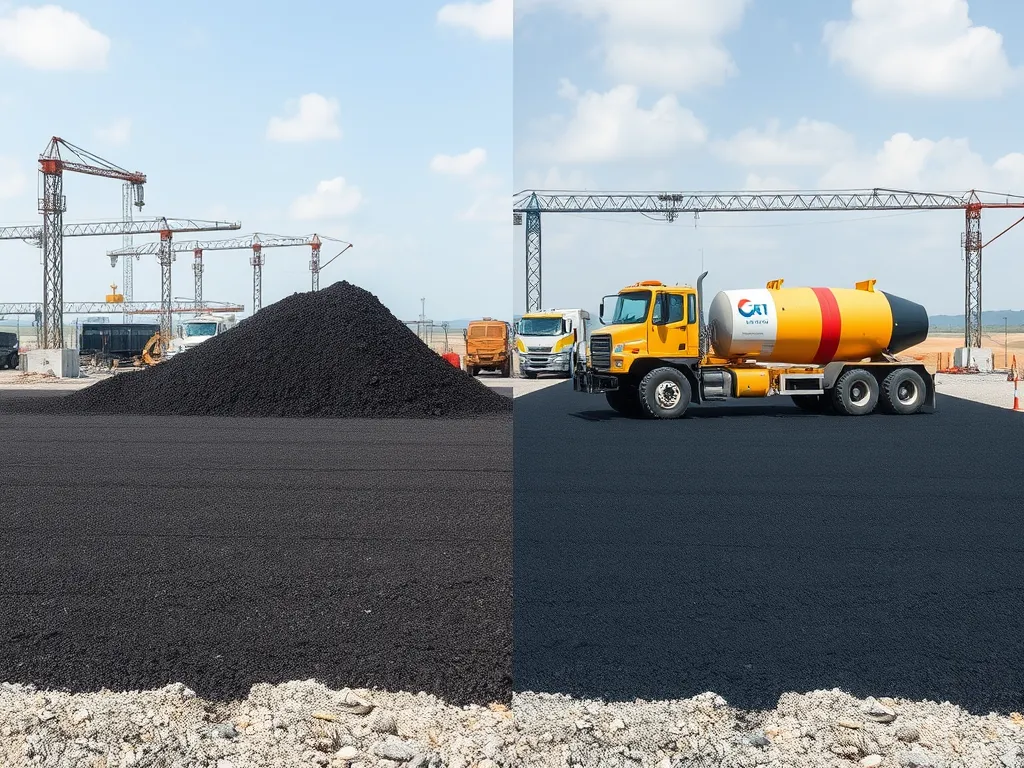Cold Mix Vs Hot Mix Asphalt: Key Differences and Applications
Published on: October 17, 2025 | Last Updated: April 14, 2025
Written By: George Voss
Cold mix and hot mix asphalt are two paving materials differing in production temperature, application methods, and performance. Hot mix asphalt (HMA) combines aggregates with liquid asphalt binder heated to 300°F-350°F, creating durable surfaces for roads and driveways. Cold mix asphalt (CMA) uses emulsified asphalt applied at ambient temperatures, ideal for temporary repairs or remote areas. HMA lasts 15-20 years under heavy traffic but costs $100-$200 per ton installed. CMA costs $25-$50 per bag but may need replacement within 2-5 years. Choose HMA for permanent high-traffic projects; pick CMA for quick fixes or low-budget needs.
This article breaks down how these mixes work, where they excel, and what fits your project. We compare their composition, production processes, and temperature requirements. Learn how climate affects performance, why HMA costs more upfront but less long-term, and when CMA’s cold application saves time. Explore pros/cons, environmental impacts, and FAQs like using cold mix for driveways or fixing potholes in winter. Get the data to decide which asphalt type meets your traffic needs, budget, and timeline.
Contents
- What is Hot Mix Asphalt?
- What is Cold Mix Asphalt?
- Cold Mix Vs Hot Mix Asphalt: Key Differences
- Primary Applications Of Hot Mix Asphalt
- Primary Applications Of Cold Mix Asphalt
- Pros and Cons Of Asphalt Mix Types
- Environmental Impact Of Asphalt Mixes
- Frequently Asked Questions
- Closing Thoughts
- Useful References for You:
What is Hot Mix Asphalt?
Hot mix asphalt (HMA) creates durable road surfaces using heated materials. This asphalt type handles heavy loads and resists cracking under stress. It’s the standard choice for permanent paving projects across North America.
Composition and Production Of Hot Asphalt Mix
Hot mix asphalt combines 95% aggregates (crushed stone, sand, gravel) with 5% liquid asphalt cement. Producers heat these components to 300°F during mixing. High temperatures let the binder coat aggregates evenly for maximum density.
Plants use two production methods: Batch plants mix materials in fixed quantities. Drum plants create continuous mixes. Both methods require energy-intensive heating systems. PG (Performance-Graded) binders improve temperature resistance – PG 64-22 handles climates from 64°C to -22°C.
Quality control follows Superpave standards. These specifications ensure proper gradation, binder content, and compaction. The result? Hot mix asphalt concrete achieves 93-97% density after rolling. This density prevents water infiltration and extends pavement life to 15-20 years.
While hot mix dominates permanent installations, alternative mixes serve different needs. Let’s examine cold asphalt’s unique production approach.
What is Cold Mix Asphalt?
Cold mix asphalt provides a flexible paving solution that cures without heat. This material handles temporary repairs and low-traffic areas where traditional hot mix isn’t practical. Unlike hot asphalt, it remains workable in cold weather and ships pre-mixed in bags for on-demand use.
Composition and Production Of Cold Asphalt Mix
Cold mix combines smaller aggregates (typically ½ inch or less) with a liquid asphalt emulsion. The emulsion contains bitumen suspended in water and chemical additives. These additives stabilize the mixture until applied. Production occurs at ambient temperatures between 50°F and 80°F—no heating required.
Manufacturers blend raw materials using drum mixers or pugmills. The emulsion coats aggregates without evaporating, allowing storage for 6-12 months. Once compacted, water evaporates, triggering the binder’s adhesive properties. Full curing takes days to weeks, depending on weather. This differs from hot mix asphalt concrete, which gains strength immediately through rapid cooling.
Cold asphalt’s lower density (135-145 lbs/ft³ vs. hot mix’s 150-160 lbs/ft³) affects load-bearing capacity. Yet its portable production and 40-60% lower energy use make it ideal for remote sites or small-scale fixes.
While cold mix offers unique benefits, its performance varies significantly from hot asphalt in key areas.

Cold Mix Vs Hot Mix Asphalt: Key Differences
Selecting between cold mix and hot mix asphalt depends on project needs, weather, and budget. Let’s break down critical factors that set these materials apart.
Performance in Various Conditions
Hot mix asphalt concrete excels in temperatures above 40°F. The heated blend (produced at 300°F–350°F) bonds tightly when compacted, creating surfaces that withstand heavy traffic and extreme heat. Cold asphalt mix uses emulsified binders that activate without heat, making it workable at 40°F or lower. While cold mix stays pliable in cold weather, it softens in sustained heat above 85°F.
Durability and Longevity
Hot mix offers 15–20 years of service on driveways and 8–12 years on highways with proper maintenance. Cold mix asphalt vs hot mix asphalt lasts 6 months to 2 years, depending on traffic and weather. Freeze-thaw cycles degrade cold patches faster, while hot mix’s density resists water penetration and cracking.
| Mix Type | Lifespan | Traffic Tolerance |
|---|---|---|
| Hot Mix | 8–20 years | Heavy (1,000+ vehicles/day) |
| Cold Mix | 6–24 months | Light (<50 vehicles/day) |
Cost Comparison: Initial and Long-term
Hot asphalt mix costs $100–$200 per ton installed but requires fewer repairs. Cold mix asphalt runs $30–$50 per ton and is DIY-friendly, saving labor fees. Over a decade, hot mix averages $0.15–$0.30 per square foot annually versus $0.50–$1.20 for cold mix due to frequent reapplications.
Application Process and Equipment Requirements
Hot mix demands heavy machinery: asphalt plants, dump trucks, pavers, and rollers. It must be laid at 275°F–300°F before cooling below 185°F. Cold mix vs warm mix asphalt needs no special tools—shovels, tampers, or basic compactors suffice. Some contractors use infrared heaters to boost cold mix adhesion in sub-50°F weather.
Knowing these differences sets the stage for evaluating real-world uses. Let’s explore where each material performs best.
Also See: Crack Sealing Process: Protect Your Pavement
Primary Applications Of Hot Mix Asphalt
Hot mix asphalt works best where strength and smooth rides matter. Made at 300°F to 350°F, it bonds tight when cooled. This makes it fit for jobs needing hard-wear surfaces.
High-traffic Roads and Pavements
Hot mix asphalt concrete handles heavy loads on freeways, streets, and airport runways. Its dense-grade mix resists rutting from trucks and cars. States like Texas and Florida use PG 64-22 binders in hot mix to fight heat cracks. Lasting 15-20 years with care, it’s the go-to for roads with 10,000+ cars per day.
Driveways and Parking Lots
Home driveways and store lots gain from hot mix’s sleek finish. The heat lets crews shape it thin (1.5-3 inches) over crushed stone. It cures fast—ready for cars in 24 hours. Though pricier ($100-$200 per ton), it outlasts cold mix by 5-8 years with seal coats every 3-5 years.
Hot mix shines where traffic never stops. Next, we’ll see how cold mix fills gaps where heat and heavy gear can’t reach.

Primary Applications Of Cold Mix Asphalt
Cold mix asphalt fills gaps where hot mix falls short. Its ease of use and low cost make it fit two key roles.
Temporary Repairs and Pothole Patching
Cold mix asphalt shines in quick fixes. Crews use it to patch potholes in winter when hot mix plants close. Made with stone and bitumen emulsion (a liquid binder), it sets without heat. This makes it work in temps as low as 20°F.
- Ready to use straight from the bag
- Stays soft for weeks, letting cars pack it down
- Costs $25-$40 per bag vs hot mix’s $100-$200 per ton
Low-traffic Areas and Remote Locations
Cold mix suits spots with light use. Think farm roads, trail paths, or driveways in rural zones. It ships in bags or bulk to sites far from hot mix plants. No need for heavy gear cuts costs by 50-70%.
- Lasts 6-12 months on paths with <100 cars per day
- Sets without steam rollers – hand tamps work
- Stores for up to 6 months for future repairs
While cold mix solves short-term needs, both types have clear pros and cons based on your project’s scope.
Pros and Cons Of Asphalt Mix Types
Each asphalt mix type serves specific needs. Weigh their strengths and limits to pick the right one.
Advantages Of Hot Mix Asphalt
Hot mix asphalt (HMA) offers top performance for heavy-duty jobs. Made at 280-350°F, it uses PG binders (performance-graded) for weather resistance. Key benefits:
- Lasts 15-20 years with proper care
- Handles heavy traffic on roads or lots
- Forms smooth, tight surfaces that repel water
HMA’s heat lets it compact fully, reducing cracks. Costs $90-$120 per ton installed.
Disadvantages Of Hot Mix Asphalt
HMA has strict use rules. Downsides include:
- Must stay hot (above 220°F) during install
- Short 1-2 hour work window before cooling
- Needs pricey gear like rollers and heaters
Cold weather halts HMA jobs. Fumes from heating may harm air quality.
Advantages Of Cold Mix Asphalt
Cold mix asphalt works without heat. It uses emulsifiers to bind materials at 40-70°F. Key perks:
- Stores for months in bags or stockpiles
- Sets in rain, snow, or below-freezing temps
- Costs 30% less than HMA ($60-$80 per ton)
Ideal for fast pothole fixes or rural roads with light traffic.
Disadvantages Of Cold Mix Asphalt
Cold mix trades ease for power. Weak points:
- Lasts 2-5 years before breaking down
- Can’t bear trucks or busy streets
- May rut in summer heat or wash out in storms
Needs frequent touch-ups. Not a fit for driveways or long-term jobs.
The choice between mix types also affects eco-impact. Let’s see how each fares for energy use and green goals.

Environmental Impact Of Asphalt Mixes
Production methods for asphalt mixes directly affect energy use, emissions, and long-term sustainability. Let’s break down how hot and cold options stack up.
Energy Consumption and Emissions in Production
Hot mix asphalt demands temperatures between 300°F and 350°F during production. This process burns fossil fuels, releasing roughly 1.5 tons of CO2 per ton of mix. Batch plants also emit volatile organic compounds (VOCs) and particulate matter (PM) during heating.
Cold mix asphalt skips high-heat steps. Emulsified binders blend with aggregates at ambient temperatures, slashing energy use by 60-70% compared to hot mix. Cold plants generate fewer emissions—under 0.2 tons of CO2 per ton produced—making them cleaner for air quality.
- Hot mix: 18-22 kWh/ton energy use
- Cold mix: 5-8 kWh/ton energy use
Sustainability Considerations for Cold Mix
Cold asphalt mix shines in recyclability and resource efficiency. It accepts up to 90% reclaimed asphalt pavement (RAP), outperforming hot mix’s 30-40% RAP limit. This cuts demand for virgin aggregates and bitumen.
Cold patch materials also reduce transport needs. Contractors can mix on-site using local materials, trimming trucking distances by 20-50 miles per project. The absence of heating preserves binder properties, allowing multiple reuse cycles without performance loss.
- 75% lower embodied carbon vs hot mix
- 95% recyclability rate for cold mix scraps
While environmental factors matter, practical concerns often drive final decisions. Up next: common questions contractors ask when choosing between asphalt types.
Frequently Asked Questions
What Are the Disadvantages Of Cold Mix Asphalt?
Cold mix asphalt, while convenient, has some drawbacks. Its lifespan is typically shorter than hot mix asphalt, lasting only 6 months to 2 years under optimal conditions. It is not suitable for high-traffic areas, as it cannot withstand heavy loads and is more prone to ruts and washouts during inclement weather. Additionally, it can become too soft in extreme heat, leading to further degradation.
Which is Better: Hot or Cold Asphalt Mix?
The choice between hot mix and cold mix asphalt depends on the specific needs of your project. Hot mix asphalt is better for permanent, heavy-duty paving, suitable for roads and commercial areas because of its longevity and superior performance under heavy traffic. Cold mix asphalt is ideal for temporary repairs, low-traffic areas, or situations where hot mix isn’t available or feasible, such as during cold weather conditions.
Can You Use Cold Mix Asphalt for a Driveway?
While you can technically use cold mix asphalt for a driveway, it is not recommended for high-traffic driveways or those that require high durability. Cold mix is better suited for temporary patches or driveways with low traffic, as it generally lasts 2-5 years and may not hold up as well under consistent vehicle weight compared to hot mix asphalt.
What is Cold Mix Asphalt Used for?
Cold mix asphalt is primarily used for temporary repairs, such as pothole patching, especially in colder climates where hot mix plants are unavailable. It is also suitable for low-traffic areas, such as rural roads, driveways in less trafficked zones, and for quick fixes in residential settings. The ease of application and storage makes it a popular choice for small repairs and maintenance work.
Closing Thoughts
Choosing between cold mix and hot mix asphalt hinges on your specific needs. Hot mix asphalt excels in durability and performance, making it ideal for busy roads and permanent installations. In contrast, cold mix asphalt offers versatility for temporary repairs and areas with minimal traffic. Both options have their place in construction, each with unique advantages and limitations.
Cost considerations are crucial, as hot mix can be more expensive upfront, while cold mix provides a budget-friendly alternative. Environmental impacts also play a role, with cold mix contributing positively to sustainability efforts.
Before making a decision, carefully assess your project requirements. Factors like traffic levels, location, and budget will guide you to the best choice. For more details on asphalt types and their applications, check out Asphalt Calculator USA.
Useful References for You:
- National Asphalt Pavement Association (NAPA, Industry Reports & Best Practices)
- What are hot mix and cold mix asphalt? – A1 Professional Asphalt & Sealing, LLC
- Hot Mix Vs. Cold Mix Asphalt: What’s The Difference?
- Hot Mix Vs. Cold Mix Asphalt: Which One Is Better For Your Road Project? – LeeBoy®
- What’s the Difference Between Hot Mix and Cold Mix Asphalt?


